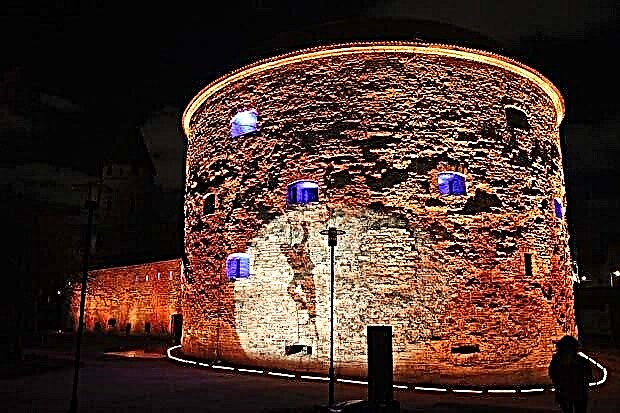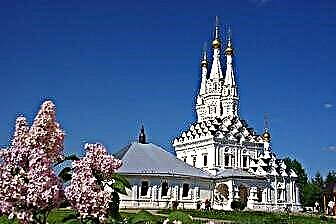Vyazma, like other small towns of Russia, is distinguished by a special, provincial-like cozy, peaceful atmosphere. Although a difficult fate fell to the lot of this city. Located on the Old Smolensk highway, which connected Russia with Europe, in both patriotic wars it suffered first. There are many memorials and monuments in Vyazma that testify to its heroic past.
Despite the large-scale destruction to which the city was subjected, merchant mansions, churches and monasteries of the 16th-18th centuries, the only surviving tower of the once powerful Vyazemsky Kremlin, have been preserved in its historical center.

The best hotels and hotels at affordable prices.
from 500 rubles / day
What to see and where to go in Vyazma?
The most interesting and beautiful places for walking. Photos and a short description.
John the Baptist Monastery
One of the most famous temple complexes of the Smolensk region. Located on the banks of the Bebri River. It was erected in the 16th century with the permission of Ivan the Terrible. As a result of two wars, it was destroyed to the ground and then rebuilt again. In 1976, restoration work began, at the end of which the monastery was revived as a male monastery, after 5 years it was transformed into a female monastery. Three main churches - Odigitrinsky, Voznesensky and Znamensky.

Church of Hodegetria
A rare beauty temple belonging to the St. John the Baptist monastery. It is of great cultural and architectural value, it is included in the UNESCO heritage list. It was built in the 17th century. Three snow-white hipped roof chapters of the church huddled together rise above the pyramid of elegant openwork kokoshniks. In Russia, besides Vyazma, only two places have preserved three-hipped temples - in Uglich and Putinki. After a large-scale restoration, services in the church were resumed in 1994.

Soviet square
Acquaintance with the city, as a rule, begins from the central square - Sovetskaya, formerly Torgovaya. Numerous monuments and objects of cultural heritage are concentrated here. These include the Mother of God Church with a museum of local lore, the building of the old customs house, the Central House of Culture, the Alley of Memory, the Smolensky Bridge, the milestone, the monuments to the Pernov Regiment, Russian bast shoes, the mother's heart, etc. From the square, the descent leads to the embankment and the Vyazma River.

Holy Trinity Cathedral
It proudly rises above all city buildings. Located in the historical center, on the Cathedral Hill. It was erected in the 17th century on the site of a wooden church. It combines features of classicism and pseudo-Russian style in its architecture. In the 20s it was closed and plundered. Services resumed in 1941 and continues to this day. Pilgrims from all over Russia go to the main icon of the temple - the Iberian Mother of God. It is believed that she saved the inhabitants of the city from the plague in the 18th century.

Museum of History and Local Lore
The date of foundation is 1912. Placed in the side-altar of the Mother of God Church built in 1727. The funds of the museum consist of 16 thousand exhibits. Here are exhibited items of peasant life and old clothes, weapons and military uniforms, archaeological and numismatic collections, personal belongings of famous natives of Vyazma. One of the expositions is dedicated to Vyazma gingerbread. An art salon is open at the museum, where works of local painters and artisans are presented.

Monument to General M.G. Efremov
It was installed in 1946 on the square of the same name. The author of the sculpture depicting the general and several of his soldiers in the last minutes of his life is E. Vuchetich. Army commander M. Efremov died in 1942, being in the Vyazemsky cauldron. He had the opportunity to escape, but he decided not to leave his comrades in arms. Having received a serious wound, the general chose to shoot himself in order to prevent the Germans from taking himself prisoner. Buried at the city Catherine's cemetery.

Monument to Anatoly Papanov
The talented and popularly beloved actor is a native of the Vyazemskaya land. Here he spent his childhood and at the age of 6 made his debut on the theater stage. The monument was opened for the 90th anniversary of A. Papanov, in 2012. The actor sits on a bench and, gesturing enthusiastically, rehearses his next role. The sculptural composition is installed in the center of the city, on the site of the house where the future idol of Soviet spectators lived before the war. This house was destroyed during the war. The author of the sculpture is I. Chumakov.

Monument to Russian bast shoes
In this original way, in 2012, they decided to perpetuate the memory of the ancient path that connected Moscow with all of Europe. It was the Old Smolensk road. It is believed that it appeared in the XIV-XV centuries, passed through Vyazma. Throughout the history of its existence, up to the XX century, many bast shoes were broken here by ordinary people. Today the road has lost its significance, and only bast shoe, as a symbol of Russian traditions and thousands of kilometers traveled, serves as a reminder of it.

Monument "Valiant Ancestors"
A symbolic dedication to the participants in the battle of 1812. A two-headed eagle, sitting proudly on a pedestal, tears at the defeated banner of the French army. At the same time, one of his heads is vigilantly directed towards the west, from where the enemy was advancing on Vyazma. The monument was erected to commemorate the 100th anniversary of the battles near Vyazma. After the revolution, the eagle was removed from the pedestal as a symbol of tsarist power, and a bust of Karl Marx took its place. The monument acquired its original appearance in 1962.

Monument to the Pernov Regiment
The heroic monument is dedicated to the warriors-grenadiers who were the first to enter the city captured by the Napoleonic army. Made in the form of a 6-meter granite column, crowned with the symbol of the Russian Empire and military valor - a two-headed eagle. The monument was erected in 1912. After the revolution, it was dismantled, and restored only on the 150th anniversary of the victory over the French. Located by the church on Sovetskaya Square.

Arkadyevsky monastery
In the 16th century, at the place where the Monk Arkady prayed 900 years ago, a wooden church was erected and a female community was formed, which was later transformed into a nunnery. It suffered from the French in 1812, but was rebuilt. After the revolution, it was finally closed. Today, the city library is located in its main cathedral, a literary salon is located in the building of the former almshouse, and a cinema has been erected on the site of the cemetery. The Spasskaya Tower and fragments of the fence have been preserved.

Spasskaya Tower
In the 17th century, the powerful Vyazemskaya fortress with 6 towers was erected by the order of the tsar. French troops destroyed it in 1812, and after that the building was not rebuilt. The only surviving fortification is the Spasskaya Tower. It consists of 3 tiers, the total height is 25 meters, the thickness of the walls at the base is 6 meters. After World War II, the tower was taken over by the Arkadyevsky Monastery and was used as a warehouse and cellar.

Transfiguration Church
In 1736, it was built on the site of the male Spassky monastery, destroyed by the Lithuanians. All costs for the construction and arrangement of the temple were covered by local merchants. After some time, the bell tower was completed in 4 tiers, the entire territory was surrounded by a fence, and a pond was built. In the last century, from the 20s to the 90s, the church was abolished, and various organizations used the building for their needs. The first prayer service, after decades of oblivion, was served in 1995.

Vvedenskaya church
The construction dates back to 1748-49. It was built on donations from Vyazma merchants and parishioners. It is made in the Baroque style, has 2 floors, the first one was “warm” - it was heated in winter. 15 years later, a bell tower was completed nearby. In the 30s of the last century, the temple stopped its work.All valuable items were seized, workshops and a club were located in the building, a substation was erected on the site of the churchyard. Services resumed in 1992.

A.S. Griboyedov (Khmelita) Museum-Reserve
A magnificent architectural and park ensemble consisting of centuries-old oaks and lindens, a cascade of ponds, a luxurious baroque manor house. This is the estate where A. Griboyedov spent his childhood and youth. Located 35 km from Vyazma. The expositions of the museum acquaint with the history of the noble family and the work of its most famous representative. On the territory of the Khmelita reserve there is also a museum dedicated to another native of the Vyazemsky region - Admiral P. Nakhimov.












